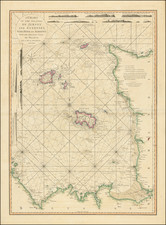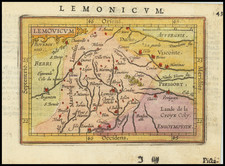Exceptional Old Color Plan of the Siege of Lille
Finely executed map illustrating the fortifications of the City and Castle and the theater of war around the city of Lille in Northern France.
The citadel and fortified city, including streets and buildings noted. Surrounding farmlands are shown with beautifully rendered windmills and houses along with mountains and forests.
The map shows the city during the War of the Spanish Succession when the city was occupied by the Dutch.
Siege of Lille
The Siege of Lille (August 12 – December 10, 1708) was a major component of the 1708 campaign season during the War of the Spanish Succession. After a defense of 120 days, the French garrison surrendered the city and citadel of Lille, commanded by Marshal Boufflers, to the forces of the Duke of Marlborough and Prince Eugene.
The siege was famous among contemporaries for l'affaire des poudres ("the gunpowder incident"), where the Chevalier de Luxembourg with 2,000 horsemen passed through the Allied lines and succeeded in delivering 40,000 pounds of desperately needed gunpowder to the defenders.
The siege was made possible by the defeat of the French army at the Battle of Oudenarde and the landing in Ostend of large amounts of ammunition and food after the Battle of Wijnendale. Eugene commanded the forces besieging Lille, while Marlborough commanded the forces covering those forces against external French interference. For a short period in late September however, after Eugene was injured on the 21st, Marlborough took command of both the besiegers and the covering force.
On October 22, 1708 the Allies entered the city. Boufflers continued to resist from Lille's citadel for several weeks. While the allies' repelled French attempts to relieve their precious fortress—the last substantial French bastion in northern Flanders—Boufflers' defense likewise prolonged the siege well into winter, to the point where no operations could be undertaken against France that year.
For France, the results of the siege were mixed. The city's stubborn defense tied down Marlborough for the remainder of the 1708 campaigning season, preventing him from inflicting further damage on France in the aftermath of Oudenarde. But, with the loss of Lille, northern Flanders reverted to allied control. The Allies moved against Ghent, taking the city in late December. The fall of Lille also opened a corridor for an allied invasion of France in 1709, but this effort would run into a bloody standstill at the Battle of Malplaquet.
Nicolaas Visscher II (1649-1702) was a prominent Dutch cartographer and publisher during the late 17th century. He was the grandson of Claes Janszoon Visscher and the son of Nicolaes Visscher I, both of whom were also renowned cartographers in their own right. After his father's death in 1679, Nicolaas Visscher II took over the family's map publishing business.
In 1680, he married Elizabeth Verseyl from Gouda, and in 1682, he obtained a new privilege from the States of Holland and West Friesland to protect his maps and publications from being copied. Visscher II continued the family tradition of producing high-quality maps, atlases, and globes, often with elaborate and decorative elements. He maintained the Visscher family's reputation for accuracy and craftsmanship in the competitive world of Dutch cartography until his death in 1702. After his death, his widow, Elizabeth, and later his son, also named Nicolaas, continued the business until around 1726.










![[ France ] Galliae Regionis Nova Descriptio](https://storage.googleapis.com/raremaps/img/small/81285.jpg)


![[ France ] Galliae seu Franciae Tabula, qua omnes Provinciae, Viae angiariae, et aliae res notatu dignae distincte et accurate ostenduntur . . .](https://storage.googleapis.com/raremaps/img/small/98436.jpg)
![[Grenoble 1968 Winter Olympics] L'Alpe D'Huez France - Isere](https://storage.googleapis.com/raremaps/img/small/84340.jpg)